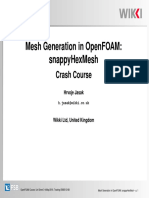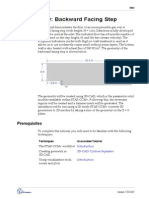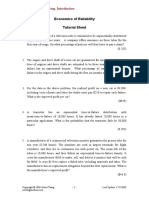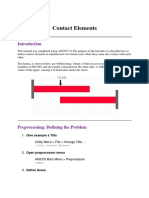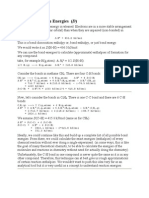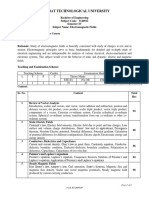Assignment Report Submission
Uploaded by
Zhen ChenAssignment Report Submission
Uploaded by
Zhen ChenTaylor Thomas s3331739
MIET2394
Computational Fluid Dynamics
Assignment A
Taylor Thomas, s3331739
Thursday, August 15, 2013
INTRODUCTION
A backward-facing step is commonly used as a benchmark for validation of numerous flow characteristics,
including physical models, multiphase flows and fundamental numerical methods. This model also has a
broad range of applications in industry, such as HVAC and combustion.
The aims of simulating this model are:
1. To learn the process of creating and exporting a mesh for quality CFD modelling.
2. To learn how to set boundary conditions and process a numerical model.
3. To explore the post-processing abilities of the CFD code to analyse numerical results.
4. To practice writing concise and well developed professional reports.
1.1 Problem description
In this report/simulation laminar flow is sent through a two dimensional backward-facing step of known
dimensions, as shown below in figure 1.
Figure 1: Illustration of the 2D geometry of a backwards-facing step
While the geometry shown above is dimensionless (normalised for the characteristic length), this simulation
will be conducted using dimensioned units; specified in the next section. The backwards-facing step is
designed so that the fluid can enter through the inlet and exit the channel through the outlet.
The outlet will be defined as an outflow, while the other boundaries will be left as no-slip walls. As this
simulation neglects turbulent flows; considering only laminar flows. No heat transfer will occur within the
specified system and dimensions will be altered throughout the report to ensure fully developed flow at the
outlet for the more aggressive simulations.
Taylor Thomas s3331739
1.2 Brief report outline
In order to conduct a comprehensive analysis of the problem illustrated above; the backward-facing step
must be tested under several different flow, material and boundary scenarios. In this report the backwardfacing step will run through four different mesh simulations; gradually refining the mesh with each
successful attempt. Four different flow characteristics will be included; simulating Reynolds numbers of
50, 100, 150 and 200. To close, this report will analyse the effects of a change in boundary conditions;
such as a change from no-slip to zero shear.
MODEL DESCRIPTION, MODEL CREATION AND MESH QUALITY
2.1 Model Geometry
The geometric model illustrated in figure 1 will be created using Ansys Design Modeler, and as specified,
will span ten units wide and a total of two units high. The simulations in this report will be conducted using
dimensioned units Metric (kg, m, s, C, A, N, V) no other units will be used in this report.
2.2 Material Information
The normalised inlet velocity and fluid properties that are also normalised for the characteristic length are
provided as:
Fluid properties: density, = 1
Dynamic viscosity, = 1/Re, where Re is the Reynolds number
2.3 Boundary Conditions
Seven named sections boundaries will be created for this simulation. All six are based on the backwardfacing step geometry and include the inlet, outlet, top wall, bottom wall, step wall, and the symmetry planes
(geometrical 2D faces, one for each face)
Inlet velocity: ux = 1 and uy = 0
Outlet: Outflow
All other boundaries: No slip
2.4 Initial Mesh Details
ANSYS Mesh will be used to generate the required mesh properties for this report. Initial mesh will be
generated automatically based on the created geometry with a fine relevance centre resulting in an initial
max face size and max size of 0.022092 m and 0.044183 m respectively.
Taylor Thomas s3331739
RESULTS AND DISCUSSIONS
This section of the report will present and briefly discuss all import and relevant findings based on the
results generated by the ANSYS CFX simulations of the backward-facing step problem illustrated in section
one.
3.1
Flow phenomenon for Re = 100 case
In this simulation ANSYS CFX was used to generate a basic laminar fluid flow through a backward facing
step at a Reynolds number of 100. The primary objective of this simulation is to determine whether or not
the flow is fully developed at the outlet or at least partially developed behind the step. The secondary
objective; if the primary is proven successful; is to determine the location of the flow reattachment point
behind the step.
Figure 2: Pressure Contour (Re = 100)
Figure 2 illustrates a pressure contour of the fluid flow through the backwards facing step. In order to
determine if the flow is at least partially developed before the step expansion, one must analyse the shape
and spacing of the contours before the step.
In this case, the pressure contour contains roughly vertical and equally spaced contour segments before the
step expansion. This is enough evidence to make the claim that the flow is indeed at least partially developed
behind the step.
Taylor Thomas s3331739
Figure 3: Velocity Contour (Re = 100)
Figure 4: Vector 1(Re = 100)
Taylor Thomas s3331739
Figure 5: Vector 1 and 2 (Re = 100)
Figure 6: Streamline and Vector 1 (Re = 100)
In order to determine if the flow is fully developed at the outlet, one needs to analyse the vector/velocity
distribution just prior and just after the outlet. Figures 3, 5 and 6 illustrate constant/uniform velocity and
fluid flow before the outlet, while figure 4 in particular illustrates uniform and fully developed flow just
outside the outlet. This is demonstrated by the curved and uniform velocity profile and even distribution of
fluid velocity.
Taylor Thomas s3331739
Reattachment
Point (u = 0)
Figure 7: Velocity vs. X and Reattachment Point
Table 1: Reattachment Point Data
x (m)
Velocity u (ms-1)
4.694
-0.0233
4.898
-0.0094
5.102
0.0013
5.306
0.0090
5.510
0.0139
The reattachment point is the point where the dividing streamline attaches to the wall again after initial
boundary layer separation. The velocity vs. X graph illustrated in figure 7 demonstrates the reattachment
point occurring at velocity u = 0. This appears logical as the flow will gradually reverse until it reattaches
to the wall and achieves an equilibrium state further downstream. Table 1 illustrates a partial set of data
from the main data set in figure 7. The approximate reattachment point is highlighted.
Taylor Thomas s3331739
3.2 Mesh independence test (Re = 100)
In this simulation ANSYS CFX is used to generate a mesh comparison of four different tiers of mesh
refinement. The objective of this simulation is to determine the sensitivity of the mesh fineness to the
location of the reattachment point. In order to achieve this objective, the mesh fineness was increased three
times over (halved three times consecutively) to generate a one half, one fourth and one eighth mesh. The
results are graphed and tabulated below.
Figure 8: Mesh 1
Figure 9: Mesh 2 (1/2)
Figure 10: Mesh 3 (1/4)
Figure 11: Mesh 4 (1/8)
Taylor Thomas s3331739
Table 2: Mesh Comparison
Mesh
Max Face Size (m)
Max Size (m)
1
2
3
4
0.22092
0.11046
0.00552
0.00276
0.44183
0.22092
0.11046
0.00552
X - Velocity Along Step Bottom wall
0.04
0.02
0
-0.04
Mesh 1
-0.06
Mesh 2 (1/2)
-0.08
Mesh 3 (1/4)
-0.1
Mesh 4 (1/8)
-0.12
-0.14
-0.16
0
10
X [m]
Figure 12: Mesh Reattachment Comparison (velocity)
Pressure Gradient_X Along Inside Wall vs. X
0.09
0.08
Pressure Gradient X [kg m-2 s-2]
Velocity u [ms-1]
-0.02
0.07
0.06
0.05
0.04
Mesh 1
0.03
Mesh 2 (1/2)
0.02
Mesh 3 (1/4)
0.01
Mesh 4 (1/8)
0
-0.01
-0.02
0
10
12
X [m]
Figure 13: Mesh Reattachment Comparison (pressure)
8
Taylor Thomas s3331739
Table 3: Mesh Comparison Data
Mesh
1
2
3
4
Velocity
Reattachment [m]
5.10204
5.91837
6.12245
6.12245
Pressure
Reattachment [m]
5.10204
5.91837
6.12245
6.12245
Table 4: Mesh Solution Runtime
Mesh
1
2
3
4
Run time (sec)
9
41
133
466
Figures 8, 9, 10, 11 and Table 2 illustrate the mesh refinement process and the degree to which each mesh
is refined.
Figures 12, 13 and Table 3 illustrate the sensitivity of the mesh fineness to the location of the reattachment
point. Under close observation it appears that the fineness of the mesh has little to no impact on the location
of the reattachment point. In this case the solution converges quite quickly resulting in an accurate enough
mesh after two refinement procedures; any further refinement does not increase solution accuracy and
results in a large increase in solution runtime, as demonstrated in Table 4.
Therefore; based on the above results; it is logical to use Mesh 3 (1/4) [Figure 10] as it provides acceptable
accuracy with a short runtime, consuming only a small amount of computational resources in the process.
However, the importance of mesh refinement should not be overlooked. Having a refined an accurate mesh
with uniform mesh geometry (preferably rectangular) is essential to obtain an accurate result. Mesh
refinement is crucial when trying to minimise truncation error; based on the below equation.
+1
=
+ ()2
(J.Y. Tu)
Taylor Thomas s3331739
3.3
Reattachment point and Reynolds number
In This Simulation, ANSYS CFX is used to compare different variations in fluid flow by altering the
Reynolds number. Similar to the mesh independence test; the objective of this simulation is to determine
the sensitivity of the reattachment point location to changes in Reynolds number. In order to conduct a
comprehensive analysis, four Reynolds number increments will be used: 50, 100, 150 and 200.
As mentioned in the mesh independence section; it is logical to use Mesh 3 (1/4) as any further refinement
is a waste of computing time. Therefore, for the sake of this simulation, Mesh 3 (1/4) will be used.
Reattachment Point vs. Different Reynolds Numbers
(Velocity)
0.005
Velocity u [ms-1]
-0.005
Re = 50
Re = 100
-0.01
Re = 150
-0.015
Re = 200
-0.02
0
10
12
X [m]
Figure 14: Reynolds Reattachment Comparison (velocity)
Pressure Gradient X [kg m-2 s-2]
Reattachment Point vs. Different Reynolds Number
(Pressure)
0.14
0.12
0.1
0.08
0.06
Re = 50
0.04
Re = 100
0.02
Re = 150
Re = 200
-0.02
-0.04
0
10
12
X[m]
Figure 15: Reynolds Reattachment Comparison (pressure)
10
Taylor Thomas s3331739
Table 5: Reynolds Comparison Data
Re
50
100
150
200
Velocity
Reattachment
[m]
3.67347
6.12245
7.95918
8.97959
Pressure
Reattachment [m]
3.67347
6.12245
7.95918
8.97959
According to the results published in figures 14, 15 and Table 5; it appears that the location of the
reattachment point has a moderate degree of sensitivity to the change in Reynolds number; definitely more
so than the effect of mesh refinement. However, the data does appear to have some convergence. Based on
the slight convergence identified above, one could make the conclusion that the data would reach a point
where an increase in Reynolds number no longer has an effect on the location of the reattachment point.
Further testing would be beneficial.
3.4
Changed Top Wall Boundary Conditions
In this simulation, ANSYS CFX is used to alter the boundary conditions of the backward-facing step
analysis. The objective is to change the Top boundary condition from Non-slip wall to specified shear
(maintaining Shear stresses of X & Y components at ZERO Pascal) for the case where Reynolds number
equals 50 (Re = 50) and determine the difference when using two different boundary conditions.
Figure 16: Pressure Contour (Top wall Boundary)
11
Taylor Thomas s3331739
Figure 17: Velocity Contour (Top Wall Boundary)
Figure 18: Vector 1 (Top Wall Boundary)
12
Taylor Thomas s3331739
Figure 19: Vector 1 and 2 (Top Wall Boundary)
Figure 20: Streamline and Vector 1 (Top Wall Boundary)
13
Taylor Thomas s3331739
Figure 22: Velocity Reattachment
Figure 21: Pressure Reattachment
It is quite clear from figures 16, 17, 18, 19, and 20 that the flow in this simulations is not fully developed.
The velocity and vector profiles do not express the uniform and constant velocity distribution required for
fully developed flow. Figures 21 and 22 demonstrates the inability of the dividing streamline to reattach to
the wall. Without successfully reattaching to the wall, the flow cannot fully develop. From these
observations; it is clear that the use of two different boundary conditions results in irregular flow that cannot
fully develop.
CONCLUSIONS
A backward-facing step is commonly used as a benchmark for validation of numerous flow characteristics,
including physical models, multiphase flows and fundamental numerical methods.
After successful completion of this problem it is clear that the above statement is correct. A backwardfacing step is a great way to demonstrate fundamental CFD procedures and generate a practical
understanding of simple fluid flow.
After careful analysis of the results from these fundamental CFD simulations, several observations can be
made.
- The separated streamline must reattach to the wall in order to achieve a fully developed flow at the
outlet.
- Mesh refinement does not appear to have a significant impact on reattachment point location.
- Change in Reynolds number does have an effect on the location of the reattachment point; at least
to a greater extent than mesh refinement.
- Having multiple different boundary conditions may result in an incomplete flow development.
-
REFERENCES
J.Y. Tu, G. Y. (n.d.). Computational Fluid Dynamics - A Practical Approach. UK: Elsevier Science Limited.
14
Taylor Thomas s3331739
15
You might also like
- A First Course in Complex Analysis Solutions Manual32% (25)A First Course in Complex Analysis Solutions Manual2 pages
- National 5 Physics Practice Workbook AnswersNo ratings yetNational 5 Physics Practice Workbook Answers26 pages
- CFD Simulation Open Foam Backward Facing StepNo ratings yetCFD Simulation Open Foam Backward Facing Step6 pages
- Numerical Study Using FLUENT of The Separation andNo ratings yetNumerical Study Using FLUENT of The Separation and24 pages
- Detailed Analysis of Backward Facing Step With Different Turbulence Models and Laminar Flow - Reattachment and Recirculation PointNo ratings yetDetailed Analysis of Backward Facing Step With Different Turbulence Models and Laminar Flow - Reattachment and Recirculation Point9 pages
- Turbulence Modeling Resource: Langley Research CenterNo ratings yetTurbulence Modeling Resource: Langley Research Center8 pages
- Chapter One Introduction and Literature Review: 1.1 Hybrid Rocket MotorNo ratings yetChapter One Introduction and Literature Review: 1.1 Hybrid Rocket Motor66 pages
- Two Way Fluid-Mechanical System Interaction Using ANSYSNo ratings yetTwo Way Fluid-Mechanical System Interaction Using ANSYS32 pages
- Multirotor UAV Propeller Development Using Mecaflux HelicielNo ratings yetMultirotor UAV Propeller Development Using Mecaflux Heliciel7 pages
- Digital Control of Dynamic Systems G F Franklin AnNo ratings yetDigital Control of Dynamic Systems G F Franklin An3 pages
- Modeling of Three-Phase Induction Motor Inverter Fault Using SimulinkNo ratings yetModeling of Three-Phase Induction Motor Inverter Fault Using Simulink13 pages
- Basics of Lattice Boltzmann Method For Fluid FlowsNo ratings yetBasics of Lattice Boltzmann Method For Fluid Flows27 pages
- 2021 Computational Fluid-Dynamics Modelling of Supersonic EjectorsNo ratings yet2021 Computational Fluid-Dynamics Modelling of Supersonic Ejectors58 pages
- Aerodynamic Characteristics of A NACA 4412 AirfoilNo ratings yetAerodynamic Characteristics of A NACA 4412 Airfoil20 pages
- Geometric Parameter Optimization of A Tuning Fork: Created in COMSOL Multiphysics 5.5No ratings yetGeometric Parameter Optimization of A Tuning Fork: Created in COMSOL Multiphysics 5.510 pages
- Daftar Buku Mechanical Engineering, ManufacturingNo ratings yetDaftar Buku Mechanical Engineering, Manufacturing398 pages
- Comsol Chemical Reaction Engineering SimulationsNo ratings yetComsol Chemical Reaction Engineering Simulations26 pages
- An Analysis of Lift and Drag Forces of NACA Airfoils Using PythonNo ratings yetAn Analysis of Lift and Drag Forces of NACA Airfoils Using Python9 pages
- Turbulence Models and Their ApplicationsNo ratings yetTurbulence Models and Their Applications52 pages
- Heat Transfer - A Review of 2000 Literature100% (1)Heat Transfer - A Review of 2000 Literature105 pages
- Degrees of Freedom Analysis For Process Control100% (1)Degrees of Freedom Analysis For Process Control6 pages
- Analytical Modeling of Solute Transport in Groundwater: Using Models to Understand the Effect of Natural Processes on Contaminant Fate and TransportFrom EverandAnalytical Modeling of Solute Transport in Groundwater: Using Models to Understand the Effect of Natural Processes on Contaminant Fate and TransportNo ratings yet
- Mathematical and Computational Modeling: With Applications in Natural and Social Sciences, Engineering, and the ArtsFrom EverandMathematical and Computational Modeling: With Applications in Natural and Social Sciences, Engineering, and the ArtsRoderick MelnikNo ratings yet
- Universiti Teknologi Mara Final Examination: Confidential AS/OCT 2010/PHY150No ratings yetUniversiti Teknologi Mara Final Examination: Confidential AS/OCT 2010/PHY15011 pages
- auB.E. (Electronics and Communication) - 4 Year Degree Course SyllabusNo ratings yetauB.E. (Electronics and Communication) - 4 Year Degree Course Syllabus89 pages
- Endoreversible Thermodynamics: Karl Heinz Homann, Josef Maximilian Burzler, and Sven SchubertNo ratings yetEndoreversible Thermodynamics: Karl Heinz Homann, Josef Maximilian Burzler, and Sven Schubert42 pages
- DC Motor Speed Control For Electric Locomotive Equipped by Multi-Level DC-DC ConverterNo ratings yetDC Motor Speed Control For Electric Locomotive Equipped by Multi-Level DC-DC Converter7 pages
- Sizing Gearboxes Under Dynamic Loading: Course AuditNo ratings yetSizing Gearboxes Under Dynamic Loading: Course Audit3 pages
- Chapter-1 (Con'd) : Fundamentals of Metal Cutting Force and Power in Metal CuttingNo ratings yetChapter-1 (Con'd) : Fundamentals of Metal Cutting Force and Power in Metal Cutting35 pages
- Experiment 101 Newton's Second Law of Motion (Procedures)No ratings yetExperiment 101 Newton's Second Law of Motion (Procedures)3 pages
- University of Cambridge International Examinations International General Certificate of Secondary EducationNo ratings yetUniversity of Cambridge International Examinations International General Certificate of Secondary Education20 pages
- Osmotic Pressure - Definition, Formula, Examples, Solved ExercisesNo ratings yetOsmotic Pressure - Definition, Formula, Examples, Solved Exercises3 pages
- Hints and Solution: Neet/Aipmt Physics Wave Optics: Sample Paper - 02No ratings yetHints and Solution: Neet/Aipmt Physics Wave Optics: Sample Paper - 025 pages
- Drop Test Simulation Made Easy With Ansys Simulation PDF100% (1)Drop Test Simulation Made Easy With Ansys Simulation PDF20 pages
- Process Dynamics and Control: By: Gemechu Bushu (AAU)No ratings yetProcess Dynamics and Control: By: Gemechu Bushu (AAU)32 pages
- Wave Equations: Optical Fiber Communication (Ofc)No ratings yetWave Equations: Optical Fiber Communication (Ofc)3 pages
- Application of Fick's Law For The Determination of DiffusivityNo ratings yetApplication of Fick's Law For The Determination of Diffusivity6 pages
- Gujarat Technological University: Review of Vector AnalysisNo ratings yetGujarat Technological University: Review of Vector Analysis3 pages
- A First Course in Complex Analysis Solutions ManualA First Course in Complex Analysis Solutions Manual
- Numerical Study Using FLUENT of The Separation andNumerical Study Using FLUENT of The Separation and
- Detailed Analysis of Backward Facing Step With Different Turbulence Models and Laminar Flow - Reattachment and Recirculation PointDetailed Analysis of Backward Facing Step With Different Turbulence Models and Laminar Flow - Reattachment and Recirculation Point
- Turbulence Modeling Resource: Langley Research CenterTurbulence Modeling Resource: Langley Research Center
- Chapter One Introduction and Literature Review: 1.1 Hybrid Rocket MotorChapter One Introduction and Literature Review: 1.1 Hybrid Rocket Motor
- Two Way Fluid-Mechanical System Interaction Using ANSYSTwo Way Fluid-Mechanical System Interaction Using ANSYS
- Multirotor UAV Propeller Development Using Mecaflux HelicielMultirotor UAV Propeller Development Using Mecaflux Heliciel
- Digital Control of Dynamic Systems G F Franklin AnDigital Control of Dynamic Systems G F Franklin An
- Modeling of Three-Phase Induction Motor Inverter Fault Using SimulinkModeling of Three-Phase Induction Motor Inverter Fault Using Simulink
- Basics of Lattice Boltzmann Method For Fluid FlowsBasics of Lattice Boltzmann Method For Fluid Flows
- 2021 Computational Fluid-Dynamics Modelling of Supersonic Ejectors2021 Computational Fluid-Dynamics Modelling of Supersonic Ejectors
- Aerodynamic Characteristics of A NACA 4412 AirfoilAerodynamic Characteristics of A NACA 4412 Airfoil
- Geometric Parameter Optimization of A Tuning Fork: Created in COMSOL Multiphysics 5.5Geometric Parameter Optimization of A Tuning Fork: Created in COMSOL Multiphysics 5.5
- An Analysis of Lift and Drag Forces of NACA Airfoils Using PythonAn Analysis of Lift and Drag Forces of NACA Airfoils Using Python
- Analytical Modeling of Solute Transport in Groundwater: Using Models to Understand the Effect of Natural Processes on Contaminant Fate and TransportFrom EverandAnalytical Modeling of Solute Transport in Groundwater: Using Models to Understand the Effect of Natural Processes on Contaminant Fate and Transport
- Mathematical and Computational Modeling: With Applications in Natural and Social Sciences, Engineering, and the ArtsFrom EverandMathematical and Computational Modeling: With Applications in Natural and Social Sciences, Engineering, and the Arts
- Universiti Teknologi Mara Final Examination: Confidential AS/OCT 2010/PHY150Universiti Teknologi Mara Final Examination: Confidential AS/OCT 2010/PHY150
- auB.E. (Electronics and Communication) - 4 Year Degree Course SyllabusauB.E. (Electronics and Communication) - 4 Year Degree Course Syllabus
- Endoreversible Thermodynamics: Karl Heinz Homann, Josef Maximilian Burzler, and Sven SchubertEndoreversible Thermodynamics: Karl Heinz Homann, Josef Maximilian Burzler, and Sven Schubert
- DC Motor Speed Control For Electric Locomotive Equipped by Multi-Level DC-DC ConverterDC Motor Speed Control For Electric Locomotive Equipped by Multi-Level DC-DC Converter
- Sizing Gearboxes Under Dynamic Loading: Course AuditSizing Gearboxes Under Dynamic Loading: Course Audit
- Chapter-1 (Con'd) : Fundamentals of Metal Cutting Force and Power in Metal CuttingChapter-1 (Con'd) : Fundamentals of Metal Cutting Force and Power in Metal Cutting
- Experiment 101 Newton's Second Law of Motion (Procedures)Experiment 101 Newton's Second Law of Motion (Procedures)
- University of Cambridge International Examinations International General Certificate of Secondary EducationUniversity of Cambridge International Examinations International General Certificate of Secondary Education
- Osmotic Pressure - Definition, Formula, Examples, Solved ExercisesOsmotic Pressure - Definition, Formula, Examples, Solved Exercises
- Hints and Solution: Neet/Aipmt Physics Wave Optics: Sample Paper - 02Hints and Solution: Neet/Aipmt Physics Wave Optics: Sample Paper - 02
- Drop Test Simulation Made Easy With Ansys Simulation PDFDrop Test Simulation Made Easy With Ansys Simulation PDF
- Process Dynamics and Control: By: Gemechu Bushu (AAU)Process Dynamics and Control: By: Gemechu Bushu (AAU)
- Application of Fick's Law For The Determination of DiffusivityApplication of Fick's Law For The Determination of Diffusivity
- Gujarat Technological University: Review of Vector AnalysisGujarat Technological University: Review of Vector Analysis





